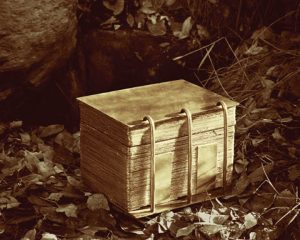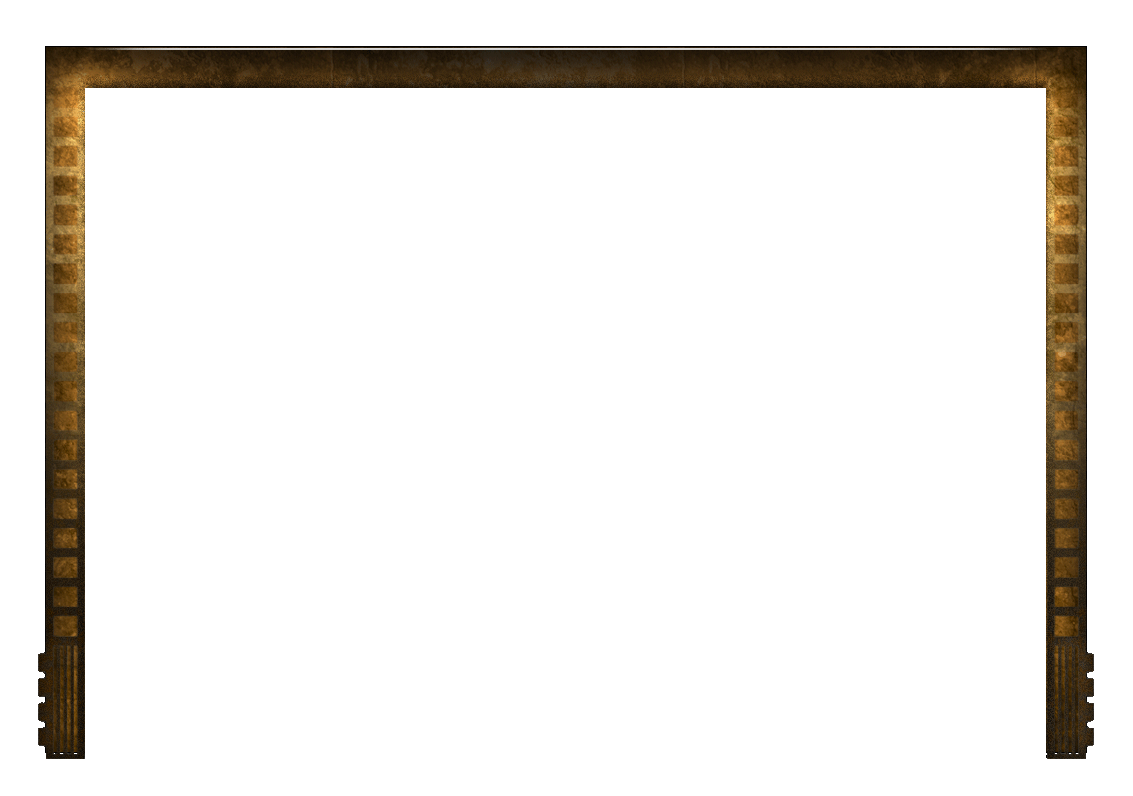Journey of Faith tracks the journey started in 600 bc by the Israelite Prophet Lehi and his family, as they made their exodus from Jerusalem across the Arabian desert to the coast, and there to the New World. Lehi’s son, Nephi, begins the account in 600 bc, preserving it by engraving on metal plates. The narrative did not come to light until the 1820s, when by divine revelation, Joseph Smith was directed to the plates from which he translated the Book of Mormon: Another Testament of Jesus Christ and unearthed them from a hill in upstate New York.
Any encounter with the divine leads to incredulity, and sometimes even persecution and martyrdom. Joseph Smith’s short life is an embodiment of that. However, when it came to the plates, the Lord provided eleven witnesses who, though they themselves were persecuted, and sometimes lost their faith, never denied that witness.
The Three Witnesses
 At the beginning of the Book of Mormon, as part of the Introduction, are two witness statements.[1] The first, “The Testimony of Three Witnesses,” is given by Oliver Cowdery,[2] David Whitmer,[3] and Martin Harris.[4] In the summer of 1829, after the translation of the Book of Mormon had been completed, the three of them with Joseph Smith went to a nearby grove to receive a witness of the Book of Mormon. In their statement, they give binding testimony that they,
At the beginning of the Book of Mormon, as part of the Introduction, are two witness statements.[1] The first, “The Testimony of Three Witnesses,” is given by Oliver Cowdery,[2] David Whitmer,[3] and Martin Harris.[4] In the summer of 1829, after the translation of the Book of Mormon had been completed, the three of them with Joseph Smith went to a nearby grove to receive a witness of the Book of Mormon. In their statement, they give binding testimony that they,
through the grace of God the Father, and our Lord Jesus Christ, have seen the plates which contain this record, which is a record of the people of Nephi, and also of the Lamanites, their brethren, and also of the people of Jared, who came from the tower of which hath been spoken. And we also know that they have been translated by the gift and power of God, for his voice hath declared it unto us; wherefore we know of a surety that the work is true.[5]
This remarkable statement was in fulfillment of prophecy in the Book of Mormon itself, given by Nephi, the son of Lehi: “Three witnesses shall behold it, by the power of God, besides him to whom the book shall be delivered; and they shall testify to the truth of the book and the things therein” (2 Nephi 27:12). Interestingly, as John W. Welch points out, “In Jewish law the Talmud stipulated that ‘at least three witnesses were required by law.’”[6]
The means of transmittal of this witness was dramatic:
“And we declare with words of soberness, that an angel of God came down from heaven, and he brought and laid before our eyes, that we beheld and saw the plates, and the engravings thereon; and we know that it is by the grace of God the Father, and our Lord Jesus Christ, that we beheld and bear record that these things are true. And it is marvelous in our eyes. Nevertheless, the voice of the Lord commanded us that we should bear record of it; wherefore, to be obedient unto the commandments of God, we bear testimony of these things.”
Although Oliver Cowdery, David Whitmer, and Martin Harris struggled against persecution and self-doubt throughout their lives, even leaving the Church for some time, they never denied the witness they had received. The promise given to them in this singular experience was one they had every hope of being fulfilled, “And we know that if we are faithful in Christ, we shall rid our garments of the blood of all men, and be found spotless before the judgment-seat of Christ, and shall dwell with him eternally in the heavens. And the honor be to the Father, and to the Son, and to the Holy Ghost, which is one God. Amen.”
The Eight Witnesses
The eight witnesses to the plates from which the record of Lehi’s family was translated were Christian Whitmer, Jacob Whitmer, Peter Whitmer, Jun., John Whitmer,[7] Hiram Page,[8] Joseph Smith, Sen., Hyrum Smith, and Samuel H. Smith.[9] In contrast to the testimony of the three witnesses to whom an angel brought the plates, the eleven witnesses were shown the physical plates by Joseph Smith:
Be it known unto all nations, kindreds, tongues, and people, unto whom this work shall come: That Joseph Smith, Jun., the translator of this work, has shown unto us the plates of which hath been spoken, which have the appearance of gold; and as many of the leaves as the said Smith has translated we did handle with our hands; and we also saw the engravings thereon, all of which has the appearance of ancient work, and of curious workmanship. And this we bear record with words of soberness, that the said Smith has shown unto us, for we have seen and hefted, and know of a surety that the said Smith has got the plates of which we have spoken. And we give our names unto the world, to witness unto the world that which we have seen. And we lie not, God bearing witness of it.[10]
Richard Lloyd Anderson tells us according to Joseph Smith’s mother, Lucy Mack Smith:
A few days after the first witnessing, the Smiths, the Whitmers, and Oliver made the thirty-mile journey from Fayette to the Smith home in Manchester, which is south of Palmyra. She said that the male Whitmers, Joseph Sr., and her sons Hyrum and Samuel accompanied Joseph Jr. into the woods where an angel had deposited the plates on a tree stump. The Eight Witnesses testified that they saw these plates, picked them up, and examined the “curious” characters. (“Curious” did not mean “strange” in that day; it meant that the characters were very carefully crafted. These men were craftsmen and artisans, remember, so they recognized fine workmanship. The witnesses also used the word heft, which is archaic for our day; it means “to lift.”) They examined the plates and bore testimony in their formal statement that they had “lifted” the gold plates.
They described the physical plates as weighing between forty and sixty pounds and being approximately eight inches long, five or six inches wide, and five or six inches thick. Their descriptions varied, from seven by five by four to eight by six by five, but the descriptions are consistent because they are estimations. They didn’t take a measurement. Not only did the Eight Witnesses see the characters and turn over the leaves, but they reported seeing a sealed part. They described the plates as bound with “D”-shaped rings, saying a perpendicular center ran through the plates, like a loose-leaf notebook, and then the ring curved in a half circle across the spine. There is definitely a consistency in what the Eight Witnesses claim they saw. [11]
Anderson has done extensive research into the lives and testimonies of the three and eight witnesses, and confirms that none of them denied the witness they had received. As an example of this, here is a letter written by John Whitmer toward the end of his life, “I have never heard that any one of the three, or eight witnesses ever denied the testimony that they have borne to the Book as published in the first edition of the Book of Mormon.”[12]
The testimony of these eleven men, added to those of Joseph himself and those who helped him with the translation add strength to the authenticity of the Book of Mormon and the narrative that forms the basis for the Journey of Faith.[13]
[1] Introduction to the Book of Mormon.
[2] Oliver Cowdery; Richard Lloyd Anderson, “Personal Writings of the Book of Mormon Witnesses,” in Book of Mormon Authorship Revisited: The Evidence for Ancient Origins, ed. Noel B. Reynolds, (Provo, UT: FARMS, 1997). Additional information on the individual witnesses and their statements are available in the Maxwell Institute’s digital collection titled “19th Century Publications about the Book of Mormon (1829–1844).
[3] The Whitmers: A Family That Nourished the Church; Anderson, “Personal Writings.”
[4] Susan Easton Black and Larry C. Porter, “Rest Assured, Martin Harris Will Be Here in Time,” Journal of the Book of Mormon and Other Restoration Scripture 20/1 (2011): 5–27; The Life of Martin Harris: Patterns of Humility and Repentance. Anderson, “Personal Writings.”
[5] Introduction to the Book of Mormon.
[6] John W. Welch, “Doubled, Sealed, and Witnessed Documents,” Insights 21/6. See Elisabeth Koffmahn, Die Doppelurkunden aus der Wüste Juda (Leiden: Brill, 1968), 12, citing Mishnah Tosephta Baba Bathra 10:12.
[7] On the Whitmer family, see The Whitmers: A Family That Nourished the Church; Anderson, “Personal Writings.”
[8] See Anderson, “Personal Writings.”
[9] For the Smith family, see The First Family of the Restoration; and variously on josephsmithjr.org and josephsmith.net. For a comprehensive treatment of the experiences of these eight witnesses, see Richard Lloyd Anderson, “Attempts to Redefine the Experience of the Eight Witnesses,” Journal of Book of Mormon Studies, 14/1 (2005): 18–31.
[10] Introduction to the Book of Mormon.
[11] Richard Lloyd Anderson, “Book of Mormon Witnesses,” citing Lucy Mack Smith, History of Joseph Smith, by His Mother, Lucy Mack Smith (Salt Lake City: Bookcraft, 1979), 151–52.
[12] Letter of 5 March 1876, addressed to “Mark H. Forest,” courtesy of Community of Christ Library—Archives; quoted in Anderson, “Attempts to Redefine.”
[13] See Daniel C. Peterson, What the Manuscripts and the Eyewitnesses tell us about the Translation of the Book of Mormon,”.

